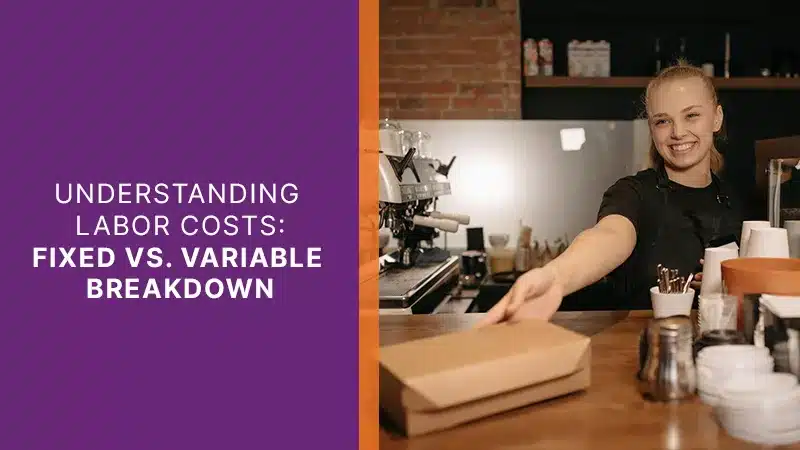The cost of labor has the biggest impact on virtually every business’s bottom line.
According to the National Restaurant Association, the costs of labor are up: 36% in full-service restaurants and 34% in limited-service establishments.
In today’s competitive market, controlling labor costs can make or break a business’s success. As organizations scale and adapt, understanding the nuances of labor expenses is essential for maximizing profitability.
Labor costs are generally categorized into fixed and variable components, each playing a pivotal role in a company’s financial health. Fixed costs remain constant regardless of output, while variable costs fluctuate with production levels, creating a unique challenge in cost analysis and budgeting.
This article will delve into the intricacies of labor costs, provide strategies for enhancing returns, and propose effective management tools to streamline these expenses. Businesses can optimize labor costs and drive productivity to new heights by investing in and rewarding employees.
How Much Does Labor Cost?
The cost of labor encompasses all employee wages, employee benefits, and payroll taxes an employer incurs for all temporary and permanent employees. These costs are divided into direct and indirect labor costs.
Direct labor costs relate to employees directly involved in producing goods and performing services, while indirect labor costs pertain to support functions like maintenance.
Salaries for a permanent workforce are typically regarded as fixed labor costs since they do not fluctuate with changes in production levels. In contrast, variable labor costs include expenses like temporary staffing, commissions, and bonuses that can change based on business performance and requirements.
Understanding both fixed and variable labor costs is crucial for businesses, as these factors significantly affect profit margins and overall profitability. Better management of labor costs can lead to optimized business expenses and improved financial outcomes.
| Type of Labor Cost | Description |
|---|---|
| Direct Costs | Costs directly tied to production processes. |
| Indirect Costs | Costs related to support functions. |
| Fixed Costs | Do not change with production levels. |
| Variable Costs | Change based on business conditions. |
Businesses must diligently consider labor costs when assessing their cost of labor strategy to achieve desired cost efficiencies.
Variable Costs vs. Fixed Costs
At this point, defining and explaining the difference between variable costs and a fixed cost may be helpful.
Variable costs fluctuate directly with changes in a company’s production volume.
As production increases, variable costs such as direct materials and direct labor also rise; conversely, they drop when production decreases. These costs are crucial for businesses to identify, as they impact the cost of labor and raw materials, influencing overall production levels and unit costs.
In contrast, fixed costs remain unchanged regardless of how much is produced. Expenses like rent and depreciation fall into this category, providing stability in financial planning. Recognizing the distinction between variable and fixed costs aids businesses in accurately forecasting expenses, determining pricing strategies, and setting the break-even point—the production level where total revenue matches total costs.
Understanding these cost types helps businesses manage overhead costs and refine budget allocations. Analyzing variable costs is essential in making informed decisions about production increases and setting competitive sale prices. Ultimately, the goal is to balance both cost types to achieve financial efficiency and profitability.
The Challenges of Assessing Labor Costs
Workers aren’t office supplies whose true costs are easy to assess. Assessing the value of worker output and its direct impact on your bottom line can be complicated.
Assessing labor costs involves categorizing them into direct, indirect, fixed, and variable expenses. Each type presents unique challenges due to complex job categories and fluctuating demand levels. For example, direct labor costs don’t always change proportionally with the work done, complicating cost assessments.
Real-time data analysis and reporting tools are essential for effective labor cost management. These tools provide insights into scheduled labor relative to projected sales, helping businesses manage expenses. Cloud-based scheduling solutions can optimize staff allocation, helping control labor costs efficiently.
How? Check out this example from Utah-based fast-casual Mexican restaurant Costa Vida.
Understanding the distinction between fixed and variable labor costs can be difficult. Companies must accurately segment costs to understand true labor expenses. Implementing specialized solutions helps in addressing these challenges, ultimately improving cost management strategies.
These tools and strategies can help navigate the complexities of labor cost calculations and enhance business decision-making.
Is Labor a Variable Cost?: How to Maximize Returns on Labor Costs
Labor is often treated as a variable cost, especially in industries such as catering, due to its direct correlation with production volume and seasonal demand fluctuations.
Understanding the true cost of an employee, which includes wages, benefits, taxes, and training, lays the groundwork for better workforce planning.
Successful labor cost management involves breaking them down into fixed and variable components, offering clearer insights for resource allocation. Adjusting labor hours based on customer demand can optimize costs and improve service quality without significantly impacting wages.
Invest in your Employees
In the restaurant industry, labor expenses as a percentage of sales can make up a third of total business costs, emphasizing the necessity of investing in employees to manage these expenses effectively.
Restaurant labor costs will be incurred whether employees are being productive or not. If you want to get the most out of the billable hours racked up by hourly workers, it pays dividends to make them as competent and capable as possible.
For example, training your wait staff in upselling can result in additional revenue per worked hour by convincing patrons to buy additional items or more expensive versions of the menu items they’re already buying. The unit of output (hours worked) remains the same, but the quantity of output expands.
Never stop training your employees. This shouldn’t be seen as a needless additional expense. Cross-trained employees with versatile skills enhance workforce flexibility, reducing the need for additional hires during high-demand periods.
Incentivize your Employees
Performance monitoring systems play a crucial role in motivating employees and boosting productivity and should be a part of every business strategy.
Implementing incentive programs such as bonuses or recognition creates a culture of excellence within the workforce. Encouraging top performers to exceed expectations by providing exceptional customer service, working additional hours, or working extra shifts will be best achieved by rewarding those who do so.
Hiring the right candidates from the start also helps reduce annual labor costs by minimizing turnover expenses.
Reward Those who go the Extra Mile… Without Breaking the Bank
Acknowledging and rewarding exceptional performance drives a competitive atmosphere, boosting team morale and productivity.
We understand that profit margins can be tight in the restaurant business, and the additional costs of giving bonuses may be too much. In these cases, get creative. There are ways to reward your best performers without hiking overhead expenses too much, and it is worth it to do so.
Developing incentive programs for top performers, such as bonuses or public recognition, fosters a culture of excellence. Encouraging employees to exceed expectations maximizes output while effectively controlling labor costs.
Continuously Collect and Analyze Labor Data
Continuously collecting and analyzing labor data provides insights for creating effective scheduling strategies aligning labor allocations with customer demand.
Breaking down labor costs by factors like the day of the week, productivity on an hourly basis, or specific meal periods (or any other period of time) reveals times with the highest or lowest variable labor costs. Up-to-date labor data enables managers to make informed staffing decisions, preventing overstaffing or understaffing and optimizing costs.
Implementing data-driven approaches can lead to more effective resource allocation and reduce unnecessary expenses while maintaining productivity.
Trends in Restaurant Labor Costs
As restaurants continue to evolve in the dynamic culinary landscape, understanding labor costs has become paramount. Labor costs typically account for a significant portion of a restaurant’s overall expenses, impacting profitability and operational efficiency directly.
In recent years, many restaurants have witnessed a steady increase in labor costs due to various factors, including rising minimum wage laws, enhanced employee benefits, and an ongoing labor shortage. Restaurants often struggle to find skilled workers, leading to competitive wage offerings.
This scenario has made it essential for restaurant management to strategize and optimize labor utilization effectively.
Use Restaurant Management Software to Manage Labor Costs
Restaurant management software may seem like another additional cost element to weigh down your books, but it can be an indispensable tool in managing labor costs, which are a significant variable expense in the food service industry.
By utilizing efficient scheduling features, managers can ensure optimal staffing levels that match sales projections, reducing unnecessary labor expenses during slow periods. This efficiency level is crucial in maintaining a favorable balance between labor costs and sales revenue.
SynergySuite’s award-winning restaurant management software offers comprehensive capabilities. It helps schedule staff intelligently and documents employee training, ensuring all employees perform at their highest level. Enhanced employee performance can lead to increased sales and a better dining experience, indirectly impacting labor costs positively.
Moreover, our intuitive software allows for real-time sales monitoring.
This helps in making dynamic staffing adjustments as needed, further optimizing labor costs. By leveraging these features, restaurants can better manage their direct labor costs and maintain control over their variable expenses, aligning labor management with fluctuating business needs.
Ready to join other restaurants who have successfully streamline their labor costs? Get in touch with us today so that we can set up a free, personalized demo to show how we can help you maximize your returns on labor.






